Introduction
In the competitive landscape of mobile applications, outsourcing iOS app development has emerged as a strategic approach that offers numerous advantages for businesses looking to optimize their operations. From significant cost savings to access to specialized talent, the benefits of outsourcing are compelling.
As organizations navigate the complexities of app development, understanding the motivations behind this trend becomes essential. By leveraging external expertise, companies can:
- Accelerate their time to market
- Enhance scalability
- Focus on their core business functions
This article delves into the key benefits of outsourcing iOS app development, provides a step-by-step guide for a successful partnership, and outlines critical considerations for selecting the right outsourcing partner, all while addressing the importance of effective risk management and post-launch support to ensure long-term success.
Why Outsource iOS App Development? Key Benefits and Motivations
To optimize your business operations, you can outsource iOS app development, which presents a multitude of advantages. These benefits include:
- Cost Efficiency: Organizations that opt to outsource iOS app development can achieve significant financial savings in their app creation processes.
By avoiding the overhead costs linked to in-house development—such as salaries, benefits, and workspace expenses—businesses can redirect funds towards innovation and growth. Research indicates that companies that outsource HR functions save an average of 27.2%. This statistic serves as a compelling parallel, suggesting that similar savings can be achieved in app creation when companies outsource iOS app development strategically.
-
Access to Specialized Talent: Companies can outsource iOS app development to tap into a diverse global talent pool, unlocking expertise in iOS app creation that may be difficult to find locally. This specialized skill set can lead to higher quality applications and innovative solutions tailored to market demands.
-
Faster Time to Market: Collaborating with an outsourced production team can significantly speed up the app creation process.
This agility allows businesses to respond swiftly to market changes, ensuring timely product launches and a competitive edge.
-
Focus on Core Business Functions: By choosing to outsource iOS app development to external experts, internal teams can concentrate on core business activities. This shift not only enhances operational efficiency but also fosters innovation, as teams are unburdened from technical tasks.
-
Scalability: Outsourcing provides the flexibility to adjust the development workforce in response to project demands. This adaptability is crucial in today's fast-paced business environment, allowing companies to scale resources up or down according to evolving needs.
Understanding these motivations assists organizations in aligning their strategies with broader business goals. For instance, a study highlighted that 90% of clients express satisfaction with their external service providers, reinforcing the positive impact of effective partnerships. Furthermore, companies that choose to outsource iOS app development to the Philippines gain from labor cost reductions of up to 70% in comparison to the United States, demonstrating how such cost benefits can improve the value proposition of contracting.
As we approach 2024, the alignment of software creation delegation with Agile methodologies highlights iterative processes and frequent communication, particularly enhancing collaboration between internal teams and external partners in the field of iOS app creation. This evolving landscape positions external resource management as a strategic imperative for businesses aiming for efficiency and growth.
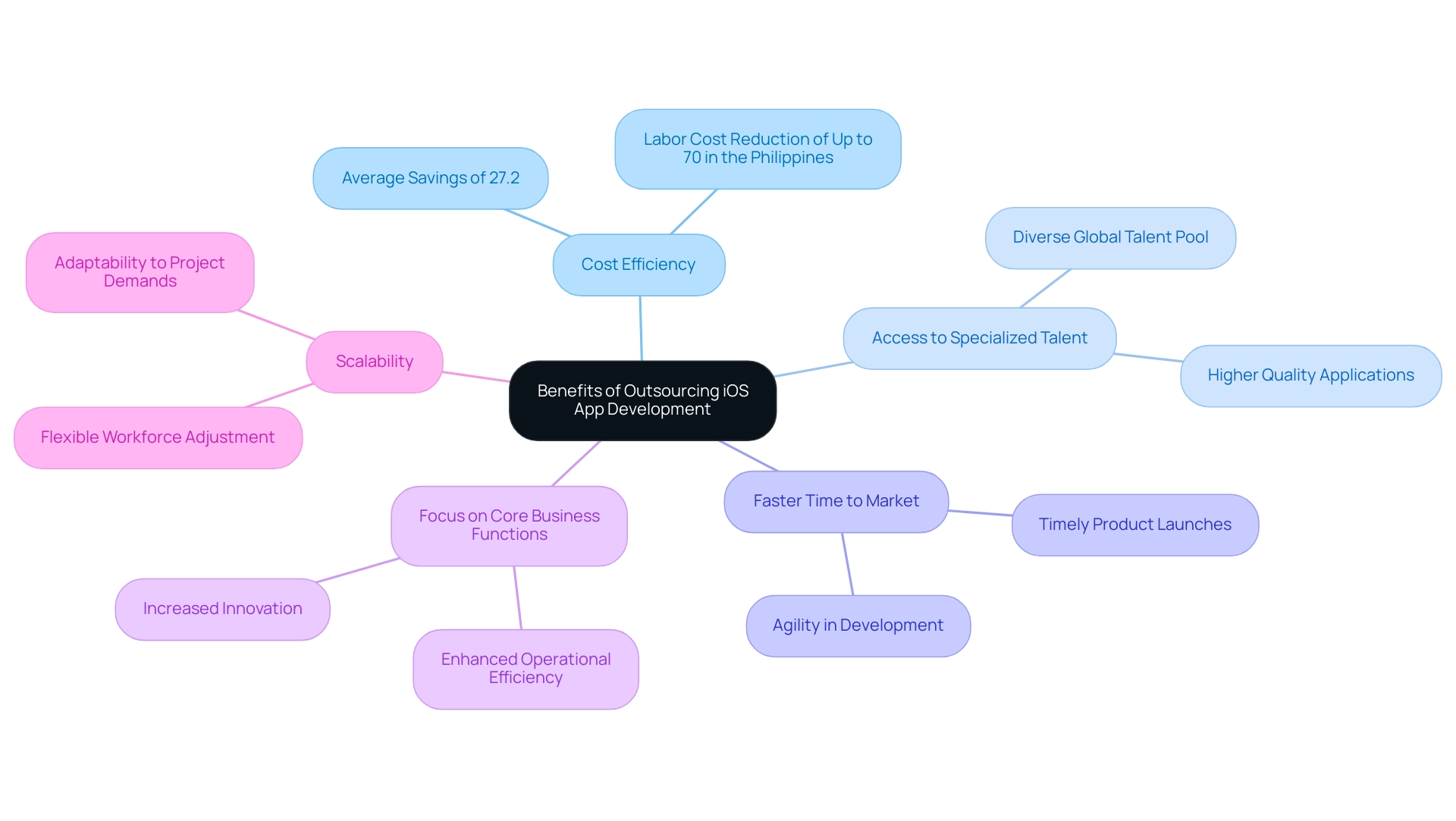
A Step-by-Step Guide to Outsourcing iOS App Development
To successfully outsource iOS app development, a strategic approach is required. Follow these essential steps to enhance your chances of a fruitful partnership:
-
Define Your Project Requirements: Begin by clearly articulating the project scope, desired features, and functionalities of your application. This clarity allows potential partners to grasp your vision, enabling them to provide precise estimates and tailored solutions.
-
Research Potential Outsourcing Partners: Target companies that demonstrate a solid track record in iOS app creation. Evaluate their portfolios, client testimonials, and case studies to gauge their expertise and reliability. In the financial services sector, 72% of organizations have chosen to outsource iOS app development, showcasing its growing significance in the industry and the need for continuous fine-tuning of business services.
-
Conduct Interviews and Assess Fit: Initiate conversations with shortlisted collaborators to assess their communication abilities, cultural compatibility, and comprehension of your project’s nuances. This engagement is crucial for establishing a collaborative working relationship.
-
Request Proposals and Compare: Solicit detailed proposals from your top candidates. Analyze their offerings, timelines, and pricing structures meticulously to make an informed selection based on your project’s specific needs.
-
Set Clear Expectations and KPIs: Upon choosing a partner, it’s vital to set unambiguous expectations regarding deliverables, deadlines, and performance metrics. This alignment will guide the project and minimize misunderstandings.
-
Maintain Open Communication: Cultivate a collaborative atmosphere by scheduling regular check-ins and updates. This proactive communication fosters transparency and enables you to address challenges promptly. A practical example of this can be drawn from the case study "Match the Communication Lines," which highlights how managing communications across different time zones is essential for successful project execution.
-
Review Progress and Provide Feedback: Continuously monitor the advancement process and offer constructive feedback. This ongoing evaluation ensures that the project remains aligned with your objectives and meets your expectations effectively.
In a landscape where companies like Aloa are simplifying the process of hiring app developers, Jiayi Zheng notes, "Today, companies like Aloa make it easier than ever to hire app developers and remote developers." Following these best practices will set you up for success in your iOS app creation efforts.
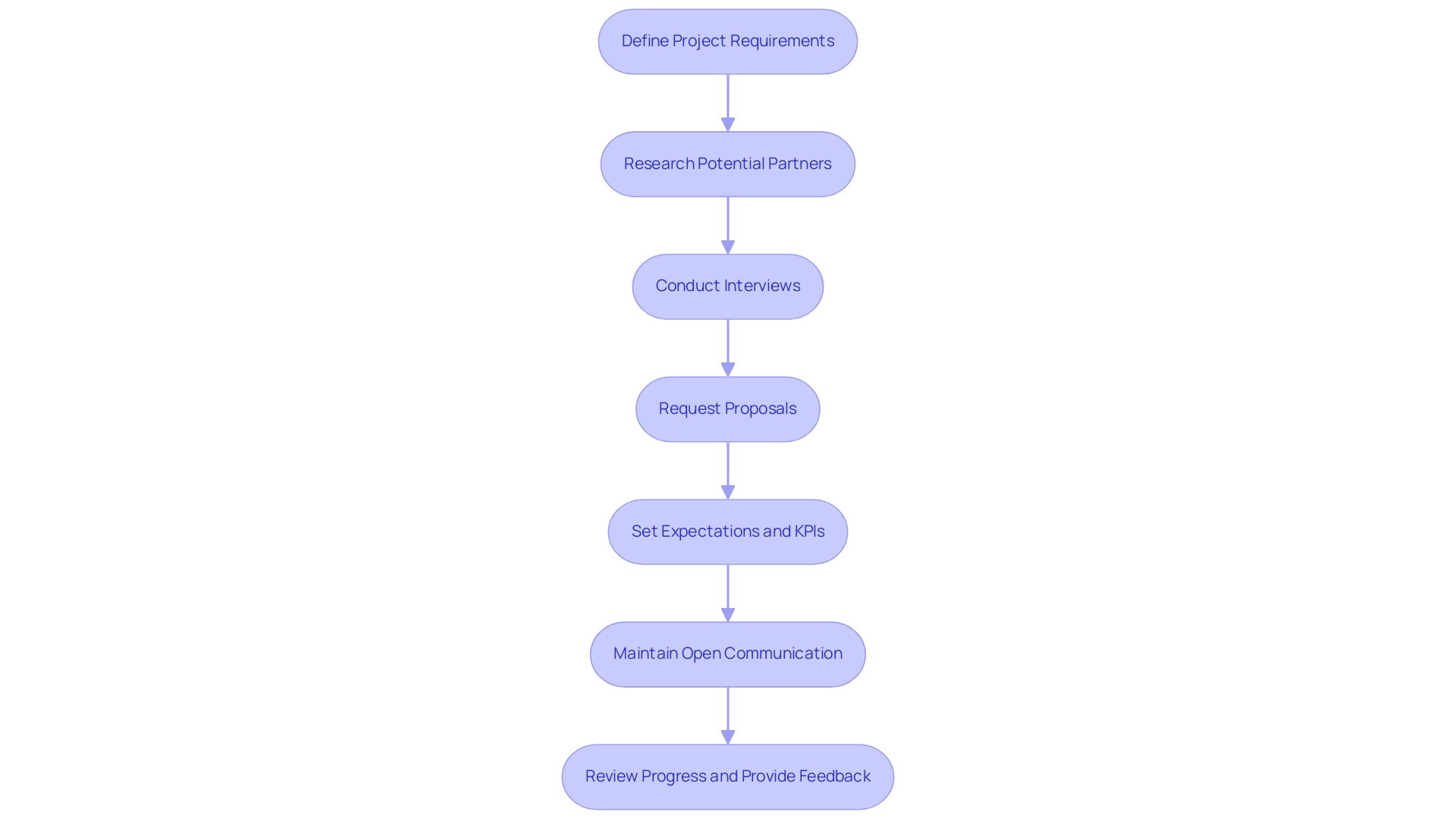
Choosing the Right Outsourcing Partner: Key Considerations
Choosing the appropriate external collaborator to outsource iOS app development is crucial for the success of your project. Here are essential factors to consider:
-
Technical Expertise: It is imperative that your associate possesses extensive experience in iOS app development, showcasing proficiency in languages such as Swift and Objective-C, along with familiarity with relevant frameworks. This technical foundation is crucial for delivering a high-quality product. As John David-Lovelock, Research Vice President and Analyst at Gartner, noted, "By 2027, in most industries, 50% more will be spent on IT contractors compared with internal IT staff, driven by the CIO’s inability to retain higher-skilled staff. There is a lot more technology coming up that needs higher skill sets." This underscores the growing need for technical expertise as companies look to outsource iOS app development.
-
Portfolio and Case Studies: Thoroughly review the collaborator's portfolio to evaluate the quality and diversity of their past projects, especially those that closely resemble your own. This examination provides insights into their capabilities and stylistic alignment with your vision. For example, many North American companies have adopted a strategic move to outsource iOS app development by nearshoring IT services, leveraging skilled labor from tech hubs like Colombia, Mexico, and Costa Rica, which allows access to high-quality IT solutions while maintaining effective communication and cultural alignment.
-
Communication Skills: Effective communication is fundamental for successful collaboration. During initial discussions, assess how well the collaborator articulates ideas and responds to queries, as this will set the tone for future interactions.
-
Cultural Fit: Cultural fit is crucial when you outsource iOS app development, as cultural alignment between your organization and the outsourcing entity can significantly influence the effectiveness of the collaboration. A shared understanding of values and work ethics fosters a more productive partnership.
-
Client Reviews and Testimonials: Investigate feedback from former clients to ascertain the individual’s reliability, professionalism, and commitment to meeting deadlines. Positive evaluations can serve as a strong indicator of the associate's overall performance.
-
Post-Launch Support: Inquire about the associate's strategy for post-launch support and maintenance. A commitment to long-term collaboration is essential, as ongoing assistance can ensure the app's continued success and adaptation to user needs.
-
Pricing Structure: Understand the pricing model used by the collaborator and ensure that it aligns with your budgetary constraints. Remember to weigh this against the value they provide, as cost-effectiveness should not compromise quality.
By prioritizing these considerations, you can enhance your project's chances of success and find a collaborator that complements your vision and technical requirements. The rising trend of contracting services, evidenced by a 156% growth in foreign companies hiring from Latin America in 2022, highlights the importance of making informed choices in selecting your service provider.
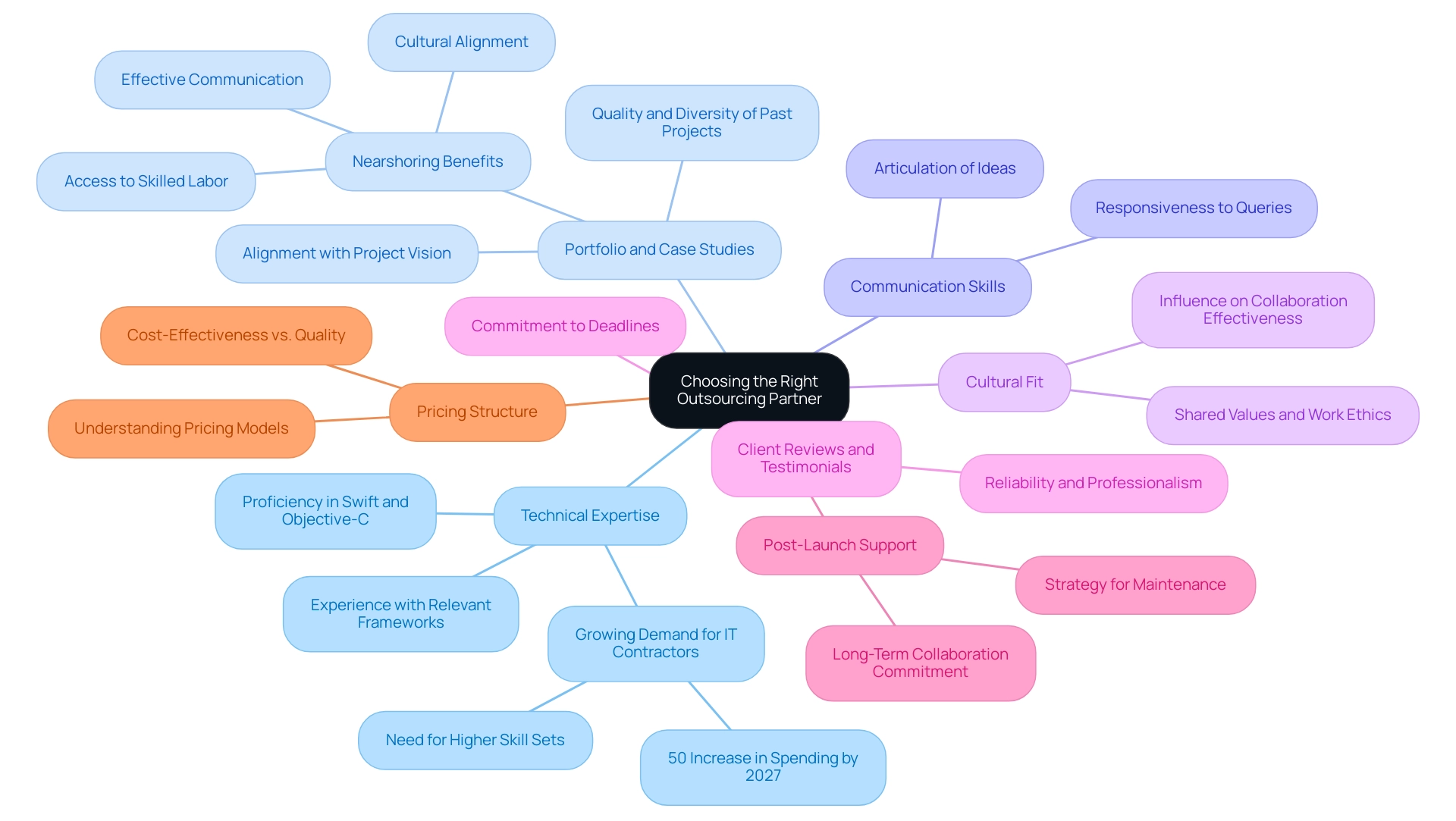
Managing Risks in Outsourcing: Strategies for Success
Effectively managing risks linked to outsourcing iOS app development is crucial for project success. The Americas generated $62 billion in external contracts throughout 2019, emphasizing the importance of this practice in the industry. Consider the following strategies to navigate this complex landscape:
-
Establish Clear Communication Channels: Reliable communication methods are essential. Establish structured communication protocols and schedules to ensure that all parties remain aligned and informed throughout the project. As emphasized by industry specialists, communication problems are a considerable challenge for 21% of companies utilizing external resources, highlighting the importance of clarity in interactions.
-
Define Roles and Responsibilities: Clearly delineate the roles and responsibilities of both your internal team and the external partner to eliminate confusion and enhance accountability. This clarity helps in managing expectations and fosters a collaborative environment.
-
Implement Regular Checkpoints: Schedule consistent progress reviews to monitor project status, address challenges, and make necessary adjustments. Regular checkpoints promote transparency and keep the project on track, facilitating timely interventions when issues arise.
-
Use Project Management Tools: Leverage advanced project management tools like Trello, Asana, or Jira to enhance collaboration, track progress, and efficiently manage tasks. These tools not only streamline workflows but also provide visibility into project timelines and deliverables, which is essential when you outsource iOS app development.
-
Test Throughout Progress: Incorporate testing phases at various stages of progress to identify and resolve issues early. This proactive approach ensures quality assurance and reduces the risk of major setbacks later in the project.
-
Document Everything: Maintain comprehensive documentation of project requirements, decisions, and changes. This practice provides clarity and serves as a valuable reference throughout the project, aiding in knowledge transfer and accountability.
-
Build a Contingency Plan: Prepare for potential setbacks by developing a contingency plan that outlines alternative courses of action in case unforeseen challenges arise. A well-thought-out contingency plan mitigates risks and ensures that your team is prepared to adapt to changing circumstances.
The project-based external resource model allows companies to manage budgets while addressing skills gaps, making it a viable option for many organizations. Implementing these strategies will not only help mitigate risks but also enhance the overall success rate of your projects, ultimately leading to a more productive and less stressful development experience. As Arshpreet Kaur notes, the external service industry in Europe is currently around $138.20 billion, reflecting its growing importance in the global market.
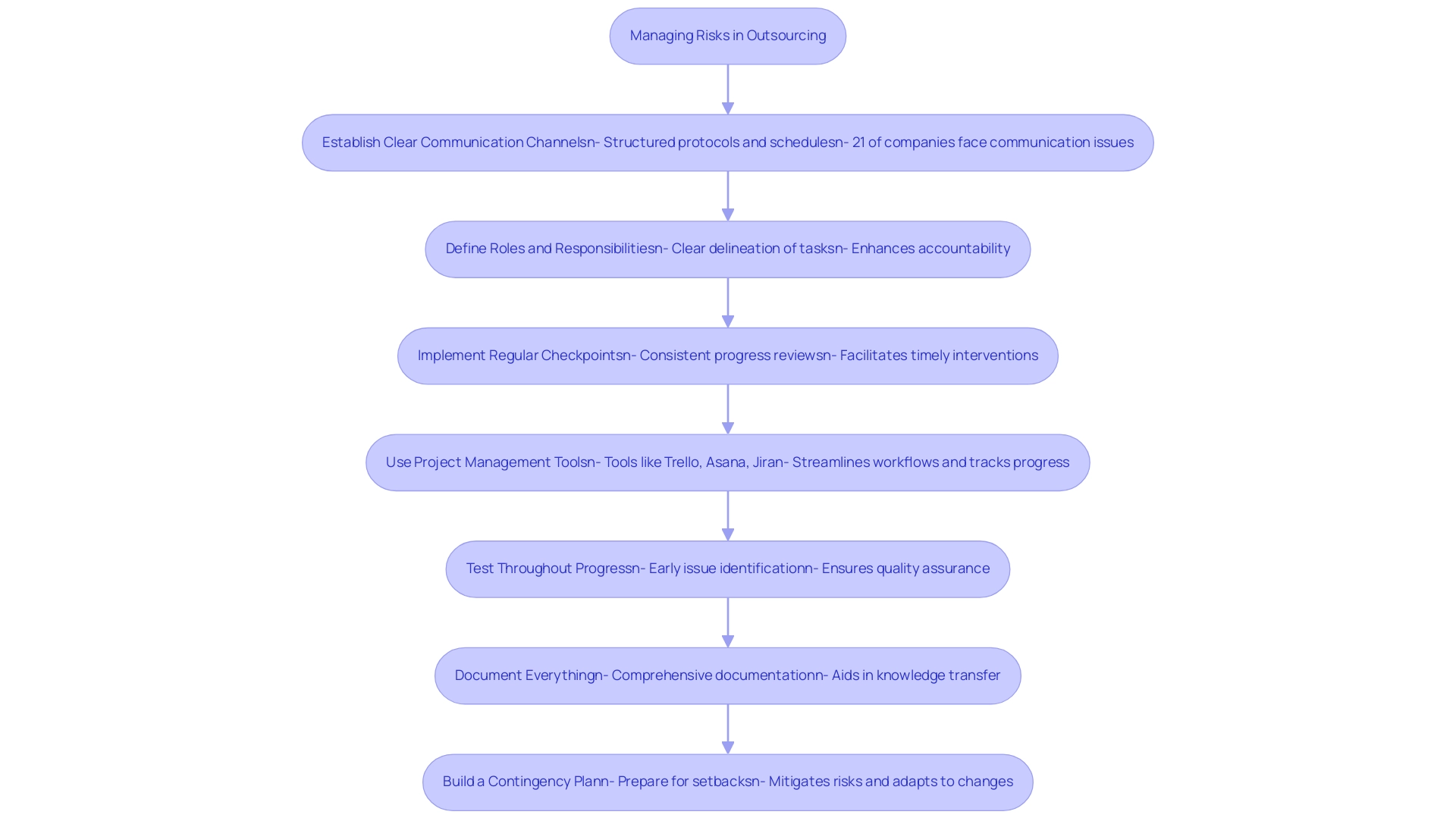
Ensuring Long-Term Success: Post-Launch Support and Maintenance
To secure the long-term success of your iOS app, implementing robust post-launch support and maintenance strategies is essential. Here are key approaches to consider:
-
Establish a Maintenance Plan: When you outsource iOS app development, work together with your external service provider to create a comprehensive maintenance plan that outlines regular updates, bug fixes, and expected feature improvements.
This proactive approach can significantly mitigate issues before they affect users. -
Monitor App Performance: Leverage advanced analytics tools to track critical performance metrics, including user engagement and feedback. By focusing on metrics such as session duration—which, according to benchmarks, correlates with improved retention and monetization rates—specifically, apps with session durations exceeding 5 minutes tend to perform better in these areas—you can pinpoint areas that require attention.
As a benchmark, this statistic serves as a vital indicator of user engagement and app success. -
Stay Updated with iOS Changes: Regularly review and update your app to ensure it remains compatible with the latest iOS updates and adherence to evolving guidelines. This practice not only enhances user experience but also protects your app from potential disruptions.
-
Gather User Feedback: Actively solicit feedback from users to gain insights into their experiences and preferences. This information is invaluable for guiding future updates and enhancements, ensuring that your app continues to meet user expectations.
-
Plan for Scalability: As your user base expands, you may want to outsource iOS app development and collaborate closely with your associate to ensure the app can scale effectively to handle increased traffic and demand.
This strategic foresight is crucial for maintaining performance during growth phases. -
Maintain Open Communication: Foster a collaborative relationship with your external partner, ensuring they remain engaged in ongoing support efforts. Open lines of communication can facilitate quicker responses to issues and better alignment on goals.
-
Evaluate Performance Regularly: Conduct periodic assessments of both your app's performance and the effectiveness of your outsourcing partnership. Identifying successes and areas for improvement allows for continuous optimization of both the product and the collaboration.
For instance, a case study on technical stability and performance monitoring highlights how utilizing tools like Crashlytics for monitoring app performance and regularly updating the app to fix bugs can prevent significant user drop-offs and improve overall user satisfaction.
By prioritizing these post-launch support and maintenance strategies, you can ensure that your iOS app not only meets initial expectations but evolves to remain competitive in an ever-changing market landscape.
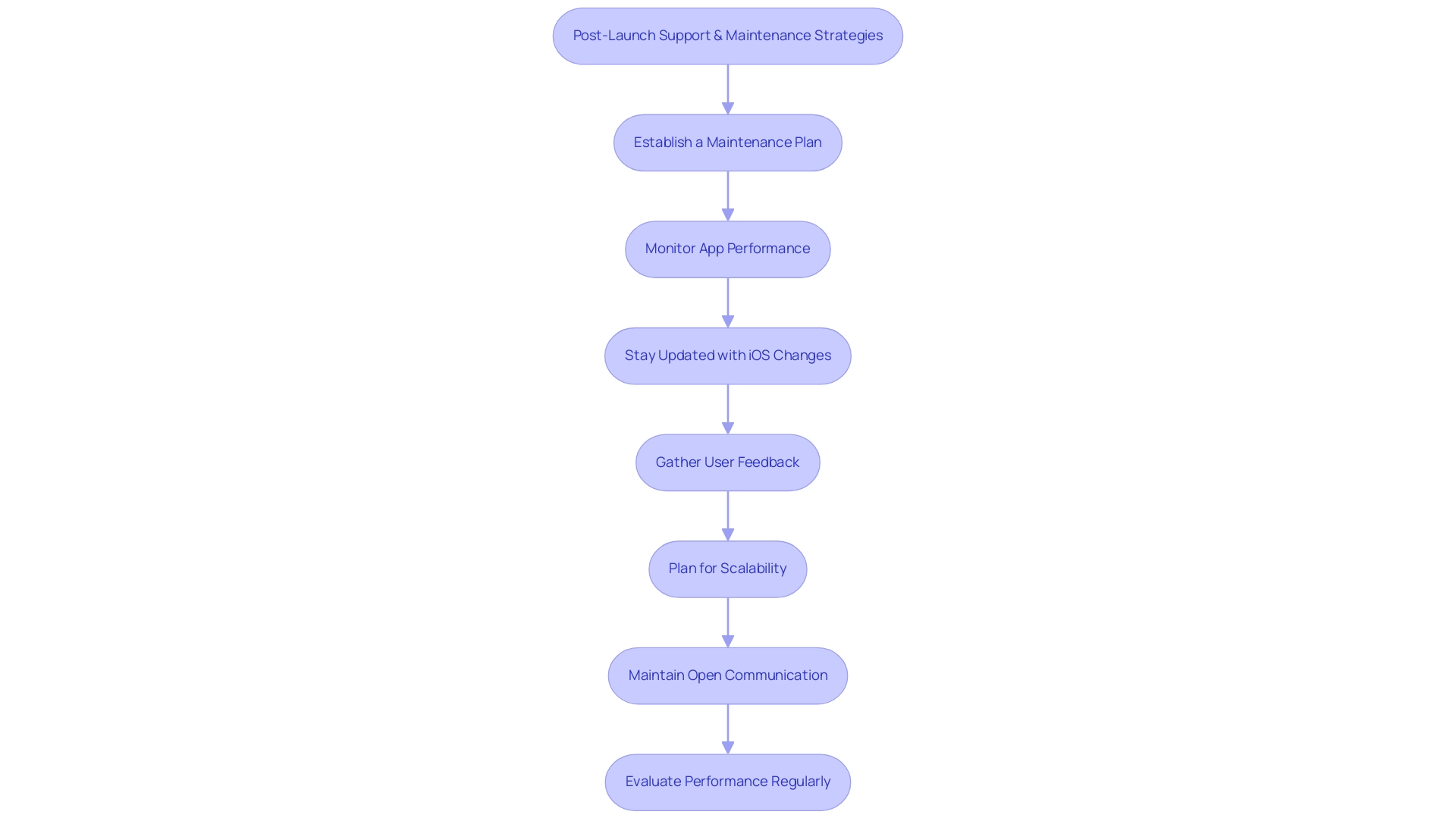
Conclusion
Outsourcing iOS app development is a potent strategy that can drive significant benefits for businesses aiming to thrive in a competitive environment. By harnessing cost efficiency, companies can redirect valuable resources towards innovation while accessing specialized talent that elevates the quality of their applications. The ability to accelerate time to market and enhance scalability further solidifies outsourcing as an advantageous approach, allowing organizations to remain agile and focused on their core competencies.
Navigating the outsourcing landscape successfully involves:
- A clear understanding of project requirements
- Diligent partner selection
- Establishment of effective communication channels
By following a structured approach, businesses can foster fruitful partnerships that align with their goals. It is essential to consider:
- Technical expertise
- Cultural fit
- The partner's commitment to post-launch support
to ensure a collaborative and productive relationship.
Risk management is also a crucial component of outsourcing success. By implementing strategies such as:
- Clear role definitions
- Regular progress reviews
- Comprehensive documentation
organizations can mitigate potential challenges and navigate the complexities of remote collaboration effectively.
Ultimately, the long-term success of an outsourced iOS app hinges on robust post-launch support and maintenance. Continuous monitoring and user feedback play a vital role in evolving the app to meet changing market demands and user expectations. As businesses embrace outsourcing as a strategic imperative, they position themselves not only for immediate gains but also for sustained growth and innovation in the dynamic world of mobile applications.





